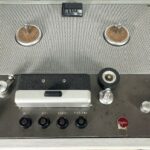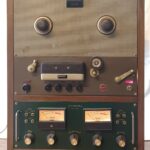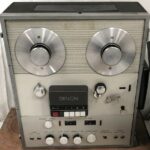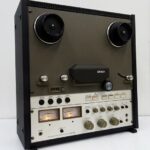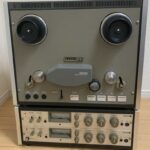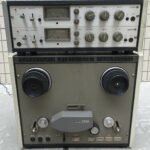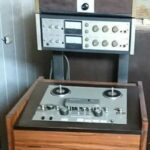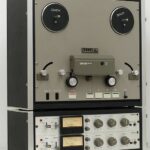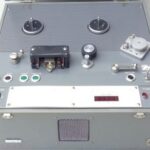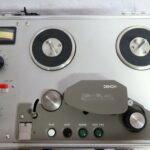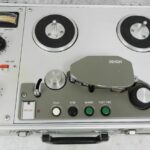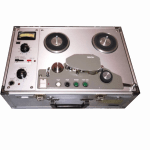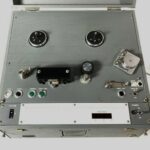In order to use this feature, you need register and become a member.
Already a member? Login Register hereDenon Reel to Reel Tape Recorders

1910 To Present
Company Description Submit New Info
Denon produced reel to reel tape recorders from 1958 to 1985 which were manufactured in Japan. These tape recorders targeted the consumer, studio and semi-pro market. The early models of Denon tape recorders used tube electronics and later on they transitioned to solid-state tape recorders. The company produced both 2 and 4 track machines available in 100v Japan, 110-120v, 220-240v & Multi voltages.
1896 – Frederick Whitney Horn, an American merchant, and owner of the F.W. Horn trading company, was involved in the import of tools (and machines) to Yokohama. He also began importing photographs and records produced by Columbia records.
1907 – He founded Japan-U.S. Recorders Manufacturing to stabilize the spread of gramophone production and disc standards.
1909 – Frederick Whitney Horn opened a factory producing discs. At the same time, he opened a recording studio, to be able to control the whole process.
1910 – Nippon Denki Onkyō Kabushikigaisha (Japan Electric Sound Company) was established by Frederick Whitney Horn in association with Japanese partners, as part of Nippon Chikuonki Shokai (Japan-US Recorders Manufacturing). Denki is Japanese for electric and Onkyo for sound.
They were the first Japanese company to sell gramophones, single-sided recording discs, and under the brand name “Nipponophone”, they became Japan’s first record label and produced Japan’s first record player.
1927– Japan Gramophone was purchased by Columbia Gramophone Ltd, and given its then name, Nippon Columbia. The company continued to serve the Far East market with records and players and began to branch out into radio broadcast equipment.
1928 – “Columbia” name was introduced when the company became Japan Columbia Recorders.
1938 – “Denon” was used by professional audio products taking the first syllables of Denki and Onkyo.
1939 – Developed Japan’s first professional disc recording machine, a twin-deck transportable device first professional-use disc recorder for the broadcasting industry the DR-148. It was delivered to Japan’s national broadcaster NHK in 1939, ready for the 1940 Tokyo Olympic Games.
1944 – The company officially became Japan Denki Onkyo Co., Ltd.
1945 – Denon made history when Emperor Hirohito’s speech to end World War II was recorded on a Denon device, the DP-17K. It was the first time the Japanese public had heard the Imperial voice. There was resistance to the transmission of the speech, and parts of the army stormed in the imperial palace to destroy the sound carriers. Therefore, the recordings were smuggled out of the palace and brought to the NHK headquarters, where the Emperor’s words were broadcast at noon on August 15, 1945. For a few years it was assumed that the original recording had been lost and that only a backup copy made by a technician secretly existed. However, later reappeared that it was kept in the NHK archive together with the original recording device to this day.
Post-World War II
1946 – Denon became a subsidiary of record company Nippon Columbia.
1947 – The company changes its name to Nippon Columbia, after absorbing Japan DENki Onkyo, it slowly becomes what we know today: DEN-ON.
1948 – R-23-A disc recorder/player was adopted as a standard by NHK, and installed in the company’s studios across Japan.
Technology began to change, with the advent of tape recorders and micro-groove discs (LP). Denon developed its first portable tape recorder that was far more convenient for reporting and interviewing than the vinyl recorders, which could at best be described as “portable”. NHK decided to use the R-28-F.
1949 – Collaboration of Tokyo Tsushin Kogyo (“Totsuko”, later Sony) and Nippon Denki Onkyo (later Denon) to produce a domestically made tape recorder using the Magnecord PT-6 model as reference. The PT-6 was already in use in Japanese broadcasting.
1951 – PT11 and PT-12 was introduced. These are the first domestically produced tape recorders for business use, and were put to use by broadcasting stations all over Japan.
Nippon Columbia develops the world’s first stereo moving-coil cartridge.
1953 – Developed a professional-use tape recorder for the broadcasting industry.
1958 – Arrival of stereo records and record players.
1959 – Began commercial production of open-reel audio tapes.
1963 – Nippon Columbia decided to create a new brand of consumer and pro audio products then adopted the brand name “DENON”. Denon quickly became a by-work for high-fidelity excellence.
1964 – Commenced sales of audio cassette tapes
1966 – Launches its first headphone model, the SH-31.
1970 – Releases its direct-drive turntable for broadcast studios, the DN-302F and for the first time the Denon name began to appear on products aimed at the consumer.
The DP-5000 was introduced, a direct-drive motor unit for record players, to which buyers could add their own plinth, arm and cartridge
1971 – Started sales of hi-fi audio components, including turntables, amplifiers, tuners and loudspeakers
1972 – Denon’s first integrated amplifier, the PMA-500, was released
1976 – Heavyweight Denon direct-drive turntables were launched. The best-selling DP-3000 model, and in by the quartz-lock direct drive DP-7000.
1978 – Commenced sales of DENON DX audiocassette tapes.
1981 – Develop the world’s first CD player for professional use, the DN-3000F.
1985 – Denon’s first AV amplifier, the AVC-500
1990 – The company launches its DTR-2000G Digital Audio Tape (DAT) deck for pro recording
1993 – Arrival of flagship S1 series he S1 models for analog sound and digital audio.
1997 – Introduced and began sales of DVD-2000 Digital Video Discplayer, continuing active role in evolution of 5″” optical disc.
2002 – D&M Holdings Inc. was created.
2009 – the DVD-A1UD arrived – the world’s first ‘universal’ disc player
2017 – Sound United LLC completed the acquisition of D+M Holdings

